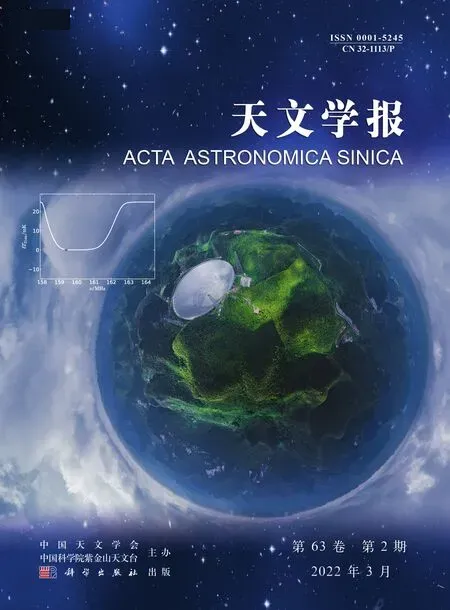DAMPE的氦核能谱以及高能天体物理研究
马鹏雄
(中国科学院紫金山天文台 南京 210023)
宇宙线的研究自19世纪末开始, 人们对其已进行了深入广泛的百年探索. 近些年人们发现宇宙线在几千亿电子伏特(几百GeV)处存在明显的能谱变硬特征, 这一发现跟此前预测的单幂律能谱存在明显的冲突, 可能对理解宇宙线加速、传播等物理过程有重要意义. 近些年空间宇宙线直接探测实验也触及TeV能段, 但对于地面实验的百TeV能段, 空间实验数据仍然较少. 这主要是因为高能段粒子数密度低且本身实验设备的有效观测面积较小. 而这一能段恰好较好地衔接了目前空间和地面实验的能区, 因此具有重要的科学意义和探索价值. 宇宙线观测历史和探测方式主要在本论文第1章介绍, 同时, 我们也着重描述一些宇宙线探测实验以及直接和间接两类探测方式的不同. 接下来的部分主要介绍本人在“悟空”号(Dark Matter Particle Explorer, DAMPE)电荷测量、氦核能谱分析等方面所开展的研究工作, 最后还将介绍我们在天体物理方面所开展的两项理论研究.
第2章介绍我们对“悟空号”的塑闪探测器(PSD)位置刻度和荧光衰减修正以及电荷重建方面开展的研究.塑闪电荷分辨率的优劣非常依赖PSD的准确位置. 我们发展了一种计算塑闪位置变化的方法, 结果显示全部PSD在探测器坐标系的垂直方向出现较显著的移动,第1、2层PSD的平均垂直移动分别为-2 mm、-1 mm; 两层PSD在其安装的水平面内出现逆时针的整体转动, 平均转动角~0.0015 rad; 所有的位置变动参数表现出随时间的稳定性. 应用PSD位置标定的参数, 电荷分辨率可以提高至少4%. 此外同一种宇宙线核子因击中点不同使电离能损测量出现最高达到2倍左右的偏差, 对此我们完成了全部PSD的荧光衰减修正. 另外, 对于重核的猝灭现象和PSD不同条的读出响应有差异, 我们提出了专门的修正方法. 基于上述系列修正, 我们完成了塑闪的电荷重建,其中质子和氦核的电荷分辨率可达到0.137和0.238个单位电荷.
第3章中首先介绍了量能器在高能量读出时的晶体饱和修正, 然后重点介绍我们对DAMPE数据的分析研究以及所获的氦核能谱测量. DAMPE的氦核能谱覆盖几十GeV到几百TeV近4个量级. 当量能器测量到几十TeV时,一些晶体会出现饱和, 我们基于模拟数据发展了高效修正晶体饱和的方法. 利用自2016年初起, 总共45个月在轨数据, 得到20 GeV/n–27 TeV/n的氦核能谱, 初步结果显示氦核能谱在TeV左右存在能谱变硬特征, 与阿尔法磁谱仪(Alpha Magnetic Spectrometer, AMS02)的发现基本一致. 此外, DAMPE氦核能谱在~10 TeV/n处存在非常显著的变软特征. 这是DAMPE首次在~10 TeV/n处发现高置信度的能谱变软特征, 与之前高空气球实验ATIC (Advanced Thin Ionization Calorimeter)、CREAM (Cosmic Ray Energetics and Mass)以及空间实验NUCLEON发现的迹象一致, 与一些地面实验发现的质子与氦核混合能谱存在几十TeV处的变软特征一致. 在TeV到几百TeV能段,目前各种地面实验的测量差别较大, DAMPE高精度的氦核能谱对宇宙线分成分的膝区特征能量测量具有重要意义.
第4章中介绍我们在高能天体物理领域的两项理论研究. 首先基于DAMPE质子宇宙线能谱和AMS02、ATIC、CREAM以及地面实验ARGO-YBJ (Astrophysical Radiation with Ground-based Observatory at YangBaJing)等的宇宙线能谱, 研究DAMPE质子谱~14 TeV变软结构的可能物理起源. 我们发现单成分的宇宙线能谱很难同时拟合宽能段的宇宙线各组分以及全粒子能谱. 基于多成分的能谱, 我们讨论了多个源模型和邻近源加背景宇宙线模型. 这两类模型均可拟合从TeV至PeV的宇宙线能谱.结合目前宇宙线各向异性的研究进展, 我们认为邻近源加背景宇宙线模型更加可信. 基于第1例双中子星并合引力波事件GW170817的数据我们对中子星最大引力质量进行了估计. 我们发现如果该次事件的伽马暴对应体GRB 170817A中心引擎是一个黑洞的话, 那么中子星的最大引力质量一般应小于2.3M⊙.
The research of cosmic rays has been started since late in 1890s and lasted more than 100 years.People have done many works extensively and deeply.In recent years, some experiment found the hardening features at a few hundred GeV compared with the conventional scenario, just single power law model.The obvious inconsistency between new discovery and conventional one may indicate some hints on understanding of acceleration,propagation and some other topics of cosmic rays. However, the recent spacebased experiments measured spectra up to several TeV as high as possible, the upper bound of energy range is lower than the ones obtained from groundbased expriments. The range from~TeV to a few hundred TeV is almost unobserved and also limited by low particle number density of high energetic cosmic ray, as well the relatively small observation area of detector. Intriguingly, this range could act as the bridge between direct observation (balloon-borne or onboard satellite and international space station)and indirect observation (ground-based), which is meaningful and important in astroparticle physics over a wide energy range.
We introduce the PSD (Plastic Scintillator Detector) position alignment, fluorescence attenuation and charge reconstruction in chapter 2. The precise position of scintillator in the frame of DAMPE(Dark Matter Particle Explorer) is essential to path length within its volume as particle passes through, which plays an important role in charge measurement. We have finished position calibration of all plastic scintillators by using flight data. For all of scintillators,the movements along the width are relative small. The movements along height are dominated, the averages are-2 mm,-1 mm for the first layer and second layer,respectively. As a whole,the rotation of PSD detector is~0.0015 rad. All of the movement and rotation are stable over operation time, we found the alignment of position is meaningful to improve the charge resolution at least by 4%. We also corrected attenuation of fluorescence within scintillator and found that the attenuation would reduce the intensity of ionization energy by twice as much as possible when one particle passes through a scintillator at different positions along its length. On the other hand, we developed methods to correct the quenching effect and non-equalization of PSD bar. After applying these corrections, the charge resolution of proton and helium are 0.137 and 0.238 charge unit, respectively.
In the third chapter, firstly, we introduce the correction to saturation at a few ten TeV. Secondly,the data analysis and helium spectrum are presented. The BGO (Bismuth Germanate) calorimeter of DAMPE could measure helium spectra from dozens of GeV to a few hundred TeV over nearly four orders of magnitude. There are some saturated readouts within calorimeter as the deposited energy as high as a few ten TeV. We developed a method to correct the saturation based on Monte Carlo data effectively. We obtained the spectrum of helium with DAMPE by using flight data with period from January in 2016 to September in 2019. The preliminary spectrum shows the hardening feature at a few hundred GeV, which is consistent with AMS02 (Alpha Magnetic Spectrometer). DAMPE also found the significant softening feature at~10 TeV/n. DAMPE found the softening with high confidence level for the first time, which are consistent with results from previous experiment ATIC (Advanced Thin Ionization Calorimeter), CREAM (Cosmic Ray Energetics and Mass)and NUCLEON.The softening also favors the breaking of proton and helium mixed spectrum by ground-based experiment. At the current stage,there are relative large uncertainties from a few TeV to a few hundred TeV in ground-based experiment,DAMPE’s high precision spectrum could be essential and crucial to measurement of knee energies of each kind of nucleus.
In chapter 4, we report our theoretical works on high energy astrophysics. We have studied the possible reason about softening of DAMPE’s proton spectrum at~14 TeV by combination with spectra of AMS02, ATIC, CREAM and ground-based experiment, i.e. ARGO-YBJ (Astrophysical Radiation with Ground-based Observatory at YangBaJing). We found the single power law could not fit the softening feature and spectra measured by air shower experiment simultaneously. Based on the multiple components spectrum,we discussed the multi sources model and nearby source with background model. Both of the two models could fit the spectra from TeV to PeV.The nearby source model could be more concrete as we took into account progress of anisotropy in recent years. We also discussed the fate of remnants by binary neutron stars (NS) merge based on the first event,GW179817,and estimated the maximum gravitational mass of NS. We found that the maximum gravitational mass of NS would be less than 2.32M⊙if the central engine of GRB 170817A was a black hole.

